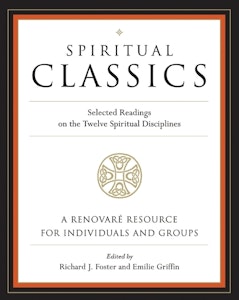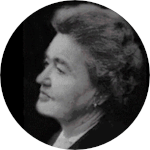Introductory Note:
Agnes Sanford (1897-1982), born in China as the daughter of a Presbyterian missionary, lived for years in New Jersey as the wife of an Episcopalian rector. Her approach to healing through prayer has been uncomplicated and very confident of God’s loving power to heal. She does not concern herself with complex questions of creed, denomination, or belief structure. Her approach is Christ-centered and church- entered. She has taught widely in many settings; she has been the instrument of many healings; and her books on healing prayer have sold in the millions around the English-speaking world.
In the following selection, taken from her much-loved book, The Healing Light, notice how Agnes Sanford concentrates on the practicality of prayer. Her recommendations are not ethereal and fanciful but exceedingly down to earth. When she recommends that we conduct experiments in prayer, she is not suggesting that we put God to the test. Instead, she wants us to put our own faith to the test. She knows that we are afraid to petition God for specific things because we are afraid of being disappointed. Therefore, she gently guides us through an orderly process that requires us, at least for the moment, to have faith and to exercise that faith in a disciplined way. At the same time her approach is wonderfully childlike. Follow her, as she follows Jesus, in the experience of healing prayer.
Renovaré Team
 Excerpt from Spiritual Classics
Excerpt from Spiritual Classics
Experiments in Prayer
The One who knew said, “Blessed are the poor in spirit, for theirs is the Kingdom of Heaven.” Happy, that is, are those people who know that their spirituality is small, that their creeds are imperfect, that their instruction concerning God and man is incomplete. Happy are those who know that they do not know all of truth. For only those who admit their spiritual poverty are willing to learn.
One way to understand a hitherto unexplored force of nature is to experiment with that force intelligently and with an open mind. This book suggests, for those willing to learn, a method so simple that it is child-like, as the more profound truths are apt to be. It is an experimental method. One decides upon a definite subject for prayer, prays about it and then decides whether or not the prayer-project succeeds. If it does not succeed, one seeks a better adjustment with God and tries again. This is the method of the men who have discovered and harnessed the forces of God’s world — the scientists.
Producing results
“Blessed are the meek, for they shall inherit the earth.” The scientific attitude is the attitude of perfect meekness. It consists in an unshakable faith in the laws of nature combined with perfect humility toward those laws and a patient determination to learn them at whatever cost. Through this meekness scientists have learned how to conform to the laws of nature, and by so doing have achieved great results. Through the same meekness those who seek God can produce results by learning to conform to His laws of faith and love.
Four simple steps into prayer
The first step in seeking to produce results by any power is to contact that power. The first step then in seeking help from God is to contact God. “Be still and know that I am God.” Let us then lay aside our worries and cares, quiet our minds and concentrate upon the reality of God. We may not know who God is or what God is, but we know that there is something that sustains this universe, and that something is not ourselves. So the first step is to relax and to remind ourselves that there is a source of life outside of ourselves.
The second step is to turn it on, by some such prayer as this “Heavenly Father, please increase in me at this time Your life-giving power.” Or if we do not know this outside life as our Heavenly Father, we can simply say “Whoever you are — whatever you are — come into me now!”
The third step is to believe that this power is coming into use and to accept it by faith. No matter how much we ask for something it becomes ours only as we accept it and give thanks for it. “Thank You,” we can say, “that Your life is now coming into me and increasing life in my spirit and in my mind and in my body.”
And the fourth step is to observe the operations of that light and life. In order to do so, we must decide on some tangible thing that we wish accomplished by that power, so that we can know without question whether our experiment succeeded or failed.
Many Christians are afraid to do this. A woman once told me that she asked God to send her two pairs of rubbers for her sons, to protect their feet from rain and slush. That night, she said, the ground froze over solid and for two days the boys walked to school dry-shod. Upon the third day another woman gave her two pairs of rubbers for her sons.
The value of specific requests
“Oh, but I would never dare do that!” cried a young man to whom I repeated this. “Because — what if the rubbers didn’t come?”
If the rubbers weren’t forthcoming, he implied — there was no God. But if he had turned on an electric light and it had failed to shine, he would not have said, “There is no electricity!” He would have said, “There is something wrong with this lamp.”
Let us understand then that if our experiment fails it is not due to a lack in God, but to a natural and understandable lack in ourselves. What scientist would be discouraged if his first experiment failed? Since we intend with His help to heal our short-comings, to repair our wiring, we need not fear to test His power by prayer.
A pair of rubbers might not be the simplest objective, nor a new coat, nor a larger home. We might be mistaken concerning our need of these things. Moreover, the attaining of such things in prayer involves the swaying of more minds than ours, and is rather difficult for a first experiment. Let us choose one of the very simplest of prayer-experiments, remembering always that it must be tangible; that is, it must be something that we can put the finger on and say either “This has been done,” or “This has not been done.”
How strange it is that people who fear to do this do not hesitate to pray for the most difficult objectives of all, such as the peace of the world or the salvation of their souls! If they have so little confidence in prayer that they do not dare to test their powers of contacting God by praying for an easy thing, it is probable that their cosmic intercessions are of little force. If everyone who prayed for the peace of the world had enough prayer-power to accomplish the healing of a head cold, this would be a different world within twenty-four hours.
An objective that is simple and personal
All the cattle on a thousand hills are His, all the rubbers in all the world are under His control and sufficient power to heal the head colds of all humanity flows at His command. Let us not be afraid, then, to choose for our first prayer-experiment an objective that is simple and personal. This objective must of course be in accordance with God’s will, for it is as difficult to make God’s power operate contrary to His will as it is to make water flow uphill. A wise engineer studies the laws of flowing water and builds his water system in accordance with those laws. A wise scientist studies the laws of nature and adapts his experiments to those laws. And a wise seeker after God had better study the laws of God and adapt his prayers to those laws.
There is no great mystery concerning the will of God, in so far as it applies to our small selves. God’s will is written into His nature, and the nature of God is love. Therefore, when we pray in accordance with the law of love, we are praying in accordance with the will of God.
Excerpted from Spiritual Classics: Selected Readings on the Twelve Spiritual Disciplines. Richard Foster and Emilie Griffin, Editors. New York: HarperCollins, 2000.
Originally published in Sanford’s 1947 book The Healing Light.
Text First Published May 2000


